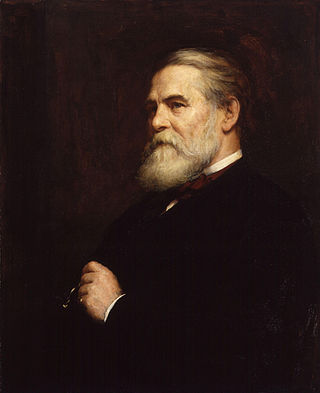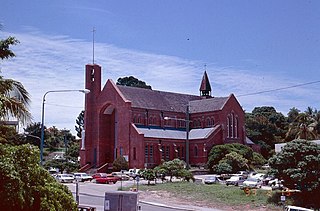
John Loughborough Pearson was a British Gothic Revival architect renowned for his work on churches and cathedrals. Pearson revived and practised largely the art of vaulting, and acquired in it a proficiency unrivalled in his generation. He worked on at least 210 ecclesiastical buildings in England alone in a career spanning 54 years.

The Cathedral Church and Minor Basilica of the Immaculate Mother of God, Help of Christians, Patroness of Australia is the cathedral church of the Roman Catholic Archdiocese of Sydney and the seat of the Archbishop of Sydney, currently Anthony Fisher OP. It is dedicated to the "Immaculate Mother of God, Help of Christians", Patroness of Australia and holds the title and dignity of a minor basilica, bestowed upon it by Pope Pius XI on 4 August 1932.

The St Saviour's Cathedral is the heritage-listed cathedral church of the Anglican Diocese of Canberra and Goulburn in Goulburn, Goulburn Mulwaree Council, New South Wales, Australia. The cathedral is dedicated to Jesus, in his title of Saviour. The current dean is the Very Reverend Gavin Krebs. It was added to the New South Wales State Heritage Register on 20 April 2009.

All Saints Hove is an Anglican church in Hove, part of the English city of Brighton and Hove. It has served as the parish church for the whole of Hove since 1892, and stands in a prominent location at a major crossroads in central Hove.

All Saints Anglican Church is a heritage-listed church at 32 Wickham Terrace, Spring Hill, City of Brisbane, Queensland, Australia. First founded in 1862, the current building designed by Benjamin Backhouse was completed in 1869, making it the oldest Anglican church in Brisbane. For most of its history, it has been identified with the High Church or Anglo-Catholic tradition within Anglicanism. It was added to the Queensland Heritage Register on 21 October 1992.

St James' Cathedral is a heritage-listed cathedral of the Anglican Diocese of North Queensland at 36 Cleveland Terrace, Townsville, City of Townsville, Queensland, Australia. It was designed by Arthur Blacket and was built in 1887 by MacMahon & Cliffe. It was added to the Queensland Heritage Register on 21 October 1992.

Christ Church Cathedral is a heritage-listed Anglican cathedral complex at Duke Street, Grafton, Clarence Valley Council, New South Wales, Australia. The cathedral was designed by John Horbury Hunt and built from 1874 to 1884 by Reynold Brothers (brickwork) and G. J. T. Lawson (woodwork). It is also known as Cathedral Church of Christ the King and Grafton Anglican Cathedral. The property is owned by the Anglican Diocese of Grafton. It was added to the New South Wales State Heritage Register on 14 March 2003.

St Paul's Anglican Cathedral is an Australian heritage-listed cathedral at 89 William Street, Rockhampton, Rockhampton Region, Queensland. It was designed principally by Annersley Voysey and built from 1883 to 1953. It is also known as St Paul's Church of England and St Paul's Church of England Cathedral. It was added to the Queensland Heritage Register on 21 October 1992. The associated hall and offices were listed on the Queensland Heritage Register on 23 June 2000.

St Mary's Church is a heritage-listed Roman Catholic church at 271–275 Adelaide Street, Maryborough, Fraser Coast Region, Queensland, Australia, on land donated to the Church by Maryborough pioneer James Cleary. It was initially designed by Charles Tiffin with later additions and alterations by Francis Drummond Greville Stanley and POE Hawkes. The initial construction was from 1869 to 1872 by G Smith and J Thomas. It was added to the Queensland Heritage Register on 21 October 1992.

St Andrews Anglican Church is a heritage-listed churchyard at 160 Vulture Street, South Brisbane, City of Brisbane, Queensland, Australia. It was designed by Andrea Stombuco and built from 1878 to 1932. It was added to the Queensland Heritage Register on 21 October 1992.

St Mark's Anglican Church is a heritage-listed church at 55 Albion Street, Warwick, Southern Downs Region, Queensland, Australia. It is the second church of that name on that site. It was designed by Richard George Suter and built in 1868 by John McCulloch. It was added to the Queensland Heritage Register on 21 October 1992.

St Luke's Anglican Church is a heritage-listed church at 152 Herries Street, Toowoomba City, Queensland, Australia. It is the second church on the site and was designed by John Hingeston Buckeridge and built in 1897. It is also known as St Luke's Church of England. It was added to the Queensland Heritage Register on 28 July 2000.

St James Church is a heritage-listed Anglican church at 145 Mort Street, Toowoomba, Queensland, Australia. It was designed by Richard George Suter and built from 1869 to 1953. It is also known as St James Church of England. It was added to the Queensland Heritage Register on 28 July 2000.

St John the Baptist Anglican Church is a heritage-listed church at 171 Oxford Street, Bulimba, Brisbane, Queensland, Australia. It was designed by John Hingeston Buckeridge and built in 1888 by T Whitty. It was added to the Queensland Heritage Register on 9 July 2003.

St Patrick's Church is a heritage-listed Roman Catholic church at 58 Morgan Street, Fortitude Valley, City of Brisbane, Queensland, Australia. It was designed by Andrea Giovanni Stombuco and built from 1880 to 1882 by John Arthur Manis O'Keefe. It was added to the Queensland Heritage Register on 21 October 1992.

St Paul's Presbyterian Church is a heritage-listed Presbyterian church at 43 St Pauls Terrace, Spring Hill, City of Brisbane, Queensland, Australia. It was designed by Francis Drummond Greville Stanley and built from 1887 to 1889 by Thomas Rees. It was added to the Queensland Heritage Register on 21 October 1992.

St John's Church is a heritage-listed Anglican church at Mundoolun Road, Mundoolun, City of Logan, Queensland, Australia. It was designed by John Hingeston Buckeridge and built from 1901 to 1915. It is also known as Memorial Church of St John the Evangelist. It was added to the Queensland Heritage Register on 26 November 1999.

St Josephs Cathedral is a heritage-listed Roman Catholic cathedral at 170 William Street, Allenstown, Rockhampton, Rockhampton Region, Queensland, Australia. It was designed by Francis Drummond Greville Stanley and built from 1893 to 1982. It was added to the Queensland Heritage Register on 21 October 1992. The cathedral serves as the seat for the Bishop of Rockhampton.

St Monica's Cathedral is the cathedral of the Catholic Church in the Diocese of Cairns. It is located at 183 Abbott Street, Cairns City, Cairns, Queensland, Australia. The cathedral was designed by Ian Ferrier and built from 1967 to 1968. It was added to the Queensland Heritage Register on 31 August 1998.

St Peter and Paul's Old Cathedral is a heritage-listed former Catholic cathedral and now parish church at 42 Verner Street, Goulburn, Goulburn Mulwaree Council, New South Wales, Australia. It was designed by Andrea Stombuco and Charles Spadacini and built from 1871 to 1890 by C. J. O'Brien and Wilkie Bros. It is also known as St. Peter and Paul's Former Cathedral and St Peter and Paul's Catholic Cathedral; Saints Peter and Paul's Catholic Cathedral. It was added to the New South Wales State Heritage Register on 20 April 2009.






























